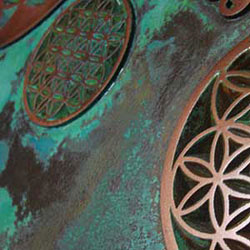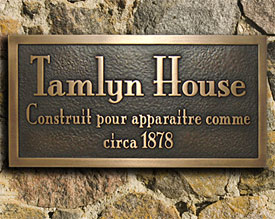Shop Profile: Signs of the Times: Atlas Signs and Plaques
 Atlas Signs custom finish
Atlas Signs custom finish Photograph courtesy of Atlas Signs
At the United States Capitol Visitor Center in Washington D.C. large frames were going to be cast in solid bronze as part of the massive space until engineers realized the wall wouldn't support the weight of solid bronze. That's where Atlas Signs and Plaques of Lake Mills, Wisconsin came into the picture.
By switching to a copper coating, they were able to provide a solution to the weight issue, reduce costs and give the application a look and feel of real bronze in the application. Similarly, Atlas created a five foot diameter plaque for the U.S. Coast Guard Academy, also in bronze, which was two inches thick and a mere 60 pounds.
It may sound too good to be true, but for Janey Fried, her business is thriving. She is not a reseller of cast copper, or brass signs and plaques, rather Atlas designs and produces every piece of signage including large format pieces in-house.
"Our signs and plaques have a high-density-urethane (HDU) base," Janey says.Originally developed for the aerospace industry, Atlas coats the HDU base material with LuminOre which gives the look and feel of foundry pieces without the weight. LuminOre is actually a metal veneer made of real copper, bronze and brass, which is cold-applied. After routing a sign for a customer and applying the copper finish to the HDU sign board, it's then placed under a UV heat lamp to aid in the bonding process. Janey then applies custom patinas and finally a marine grade clear coat to seal it.The end result is a copper veneer sign than is lightweight and less expensive than traditional casting with an authentic look.
 Artsy Signs historic marker with custom finish
Artsy Signs historic marker with custom finish Photograph courtesy of Atlas Signs
"We are able to produce a historic plaque that looks like it was cast from bronze, brass, or copper 200 years ago," she says.
Her business is booming and sales are coming in from Canada, Hong Kong, Singapore, Australia, even Russia. Entrance and number signs in the Craftsmen style are the most popular but Atlas also creates custom signs and plaques for every person and style imaginable, from whimsical to traditional, all of which come in a variety of patinas.
"It's fun being a chemist," she says as she applies a patina to a recently made copper sign. Some of the patina's are off the shelf, others are recipes she has created. "I love the chemical reaction, it's like magic."
It might be magic, but she also is about the business of educating people about copper metals. "I don't think most consumers understand the difference between copper, bronze and brass, which is unfortunate and I try to do some education with my blog," she says. She also sources nearly all materials from the U.S. Ultimately what Atlas provides is quality, craftsmanship and reasonable pricing. "Atlas offers a lower cost option while still utilizing copper and bronze," she says.
Resources:
Also in this Issue:
- Tom Otterness' Life Underground
- Brian Western: Giving New Life To Bottles Through Stained Glass
- Copperista: Uniquely Handcrafted Copper Creations from Amy Volchok
- Shop Profile: Signs of the Times: Atlas Signs and Plaques
- Frank Lloyd Wright Copper Urn and Other Rarities up for Auction at Christies
